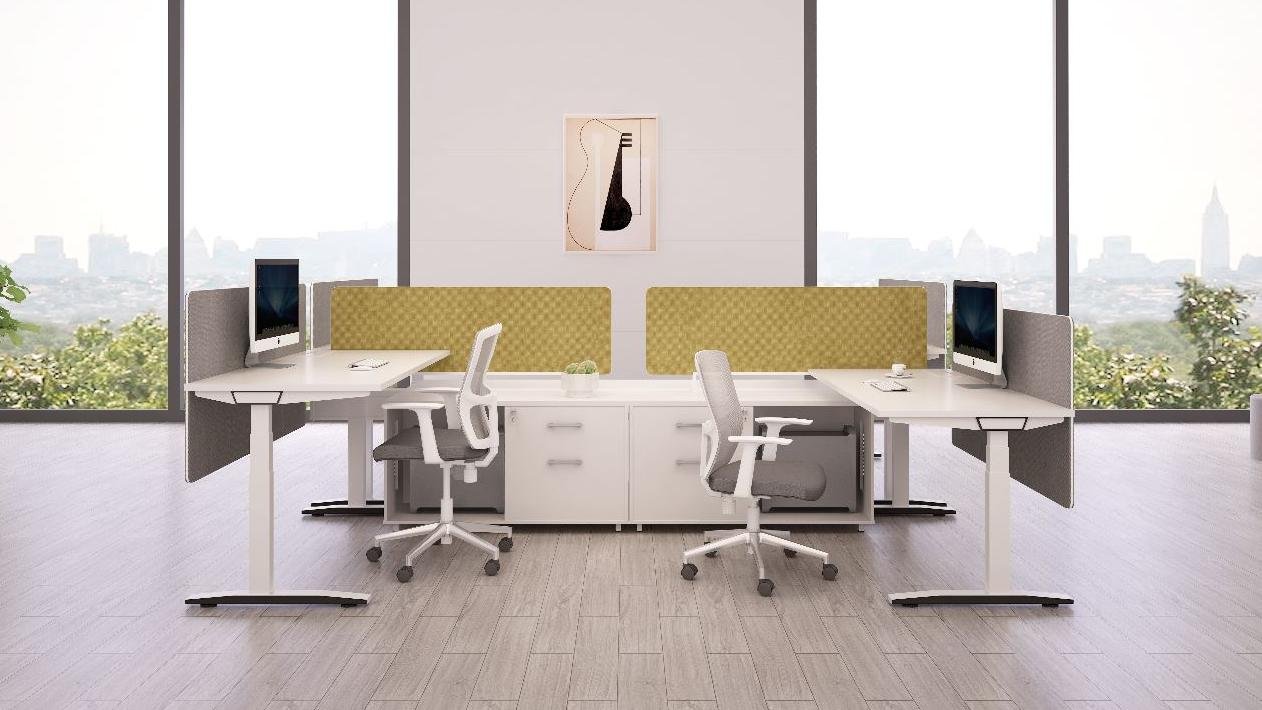With a packed schedule and long work hours, it’s easy to find yourself sitting for long stretches. As time passes, you might be hunched over your computer, your back aching, and your shoulders stiff. If that sounds familiar, switch between sitting and standing at work.
Standing desks have really caught on in recent years. With so many options popping up, some clarification still needs to be around them. Some people need to be convinced they actually help, while others think it’s just a gimmick to get you to spend more. So today, let’s dive into the real benefits of a standing desk and how to choose one.
Table of Contents
- What is a Standing Desk?
- 10 Health Benefits of Using a Standing Desk
- 1. Reduce the Risk of Weight Gain and Obesity
- 2. Alleviate Back and Neck Pain
- 3. Boost Higher Productivity
- 4. Lower Your Blood Sugar Levels
- 5. Prevent Cardiovascular Diseases
- 6. Improve Better Posture
- 7. help tone muscles and improve posture
- 8. Reduce the Risk of Cancer
- 9. Keep Circulation Going
- 10. Support Long-Term Well-Being and Help You Live Longer
- Our Standing Desk Solution
- Final Thoughts
What is a Standing Desk?
A standing desk, also known as a height-adjustable, sit-stand, or stand-up desk, lets you do your work—whether writing, drawing, or typing—while standing up or sitting on a tall stool. While research is still in its early days, there are signs that standing desks can offer some pretty great health benefits and may even boost productivity.
Some of the more advanced models have memory settings, letting you save your favorite desk heights and switch between them with just a panel. Plus, there are various types of standing desks available, so you can find one that suits both your workspace and your budget:
- A fixed standing desk, or a non-adjustable desk, stays at one height and can’t be changed. While it’s a quick solution if you want to stand for a bit in an office or shared space, it could be better for long-term use since there’s no option to sit. This can lead to discomfort after a while, unlike adjustable desks that let you easily switch between sitting and standing.
- Electric height-adjustable standing desks have a motor that allows you to switch the desk height with the press of a button. They come in two types: single motor and dual motor. A single motor moves the desk legs together, while dual motors use one motor per leg, allowing them to handle more weight—perfect if you’ve got multiple monitors or a lot of desk gear.
- Manual standing desks, also called mechanical or crank desks, let you change the height by turning a hand crank. It’s slower and less convenient than an electric desk, but they’re usually much more affordable, making them a good option if you’re on a tight budget.
10 Health Benefits of Using a Standing Desk
1. Reduce the Risk of Weight Gain and Obesity
Almost everyone knows that weight gain happens when you ingest more calories than you take in. One simple way to burn a few extra calories each hour is by standing instead of sitting while you work, which can help lower the risk of weight gain and obesity.
Over time, those extra calories burned can really add up. If you stand regularly throughout the year, the impact on calorie burn can be significant. To expand the benefits of using a standing desk, try exercising while you work. For instance, marching in place can burn up to 225 calories per hour and might even boost brain activity, helping you stay more productive and energized.
2. Alleviate Back and Neck Pain
If you sit all day, chances are you’ve dealt with some back or neck pain. Sitting for long periods puts much pressure on your spine and can even lead to disc issues. Plus, when you’re staring at a screen for too long, it’s easy to start slouching. If your monitor isn’t set up right, forcing you to look down can strain your neck.
Some experts studied a group that tried sitting, standing, or walking for one, two, and four weeks. As time went on, the group reported less lower back pain, reduced shoulder tension, better posture, and an overall boost in mood and comfort. If you’re trying to ease neck or back pain, a standing desk might be just what you need.
3. Boost Higher Productivity
A study found that using a standing desk didn’t affect typing speed or lead to more errors. But with all the benefits standing has on health, mood, energy, focus, and executive function, it can definitely help fight off that afternoon productivity slump.
Standing, especially when paired with regular movement breaks, boosts blood flow to the brain. This increase in circulation lifts your mood and energy and greatly impacts focus, concentration, and creativity. Whether you’re drafting a report, planning a marketing campaign, or designing a building, that’s a huge advantage.
“Boost your productivity” is something any boss loves to hear, and it might even help convince your company to invest in standing desks.
4. Lower Your Blood Sugar Levels
After we eat, our blood sugar levels rise, and the bigger the spike, the greater the health risk—especially if we’re insulin-resistant or have Type 2 Diabetes. A small 2014 study found that standing for three hours after lunch lowered blood sugar spikes by up to 43%. Another study showed that switching between sitting and standing every 30 minutes reduced the spike by more than 11%.
If you’re looking to manage your blood sugar level and reduce the risk of having Type 2 Diabetes later on, using a standing desk or starting a sit-stand routine can be really helpful.
5. Prevent Cardiovascular Diseases
Back in the 1950s, it was discovered that bus conductors who spent their shifts standing had a 50% lower chance of dying from heart disease than their driver colleagues who sat all day. Fast forward to 2013, and a study comparing 18 different research pieces involving nearly 800,000 people found the same thing. A sedentary lifestyle was linked to a 90% higher risk of dying from cardiovascular disease and an even more alarming 147% increase in heart-related issues compared to those with active lifestyles.
While regular exercise is ideal, standing instead of sitting is better than doing nothing. Standing at work improves circulation and helps keep your heart in better shape. Just remember to move around and stretch occasionally.
So, if you want to care for your heart, stand up more during your workday.
6. Improve Better Posture
Our bodies have evolved over thousands of years to favor standing upright. Unless our desks and chairs are perfectly set up and we make a real effort to sit correctly, we strain our spine, neck, and joints. On the other hand, using a well-setup standing desk—and paying attention to how you’re standing—can help improve your posture and bring all the benefits that come with it. As we mentioned earlier, it’s best to ease into it. Over time, you’ll find a balance between sitting and standing that feels right for your body.
7. help tone muscles and improve posture
It’s no surprise that standing for an hour works more muscles than sitting. By standing throughout your workday, you can help strengthen your core, legs, ankles, and feet.
It might take time to adjust if you’re starting to add standing to your routine. Instead of jumping straight into a 4-hour standing session, try increasing your standing time gradually.
For good posture, while standing, keep your feet aligned under your hips, stand up straight, tuck your tailbone, pull your shoulders back, and keep your head high with your chin parallel to the floor. Along with better posture and stronger muscles, you might also boost your metabolism, helping you burn more calories each hour.
8. Reduce the Risk of Cancer
A study published in the American Journal of Epidemiology in 2018 found that sitting for long periods during leisure time is linked to a higher risk of cancer, including colon, endometrial, and lung cancers.
With so much of our day spent in front of screens, finding ways to cut down on sitting is a big plus. Since many of us sit for around eight hours during the workday, switching to a standing desk can be an easy fix to help reduce that time.
9. Keep Circulation Going
Looking back at human evolution, our bodies were built for movement. When we stand, we strengthen our leg muscles, improve balance, and engage our core. Standing also helps prevent blood clots from forming in the legs. When people sit for long periods, like on a plane, blood can slow down and pool in the legs, which, in the worst cases, can lead to a clot.
Standing at your desk improves blood flow compared to sitting. Sitting too long can slow circulation, causing issues like swollen ankles, blood clots, nerve problems, and varicose veins. Standing helps keep circulation going to your legs and feet, so getting up, stretching, standing, and walking around regularly to stay healthy is important.
10. Support Long-Term Well-Being and Help You Live Longer
18 different studies found that people who sit the most have a 49% higher risk of dying earlier than those who sit the least. Another study estimated that if Americans reduced their sitting time to just 3 hours a day, it could add two years to their life expectancy. While these studies don’t prove a direct cause and effect, the evidence suggests that standing more often could help you live longer.
Sitting for long periods raises the risk of heart disease, cancer, and diabetes. By cutting back on sitting, you’re lowering your chances of these health problems and potentially increasing your lifespan.
Our Standing Desk Solution
At Meet&Co, our goal is simple: to create products that improve everyone’s lives. Our height-adjustable standing desks are designed with that in mind.
We’ve got sit-stand desks to suit any need. The Sendi is a great option if you’re looking for a desk with plenty of space for your laptop, monitors, and more. It features a motorized height adjustment panel with four memory settings, so you can easily set it to your ideal height. Plus, it has a durable work surface and built-in cable management to keep things organized.
If you’re working with limited space, the Sendi Height Adjustable Standing Desk is perfect. It offers just enough room for your work-from-home setup without needing a big office.
Need help picking the right desk? Check out our desk buying guide for all the details!
Final Thoughts
If you live a sedentary lifestyle, standing will be your key to living healthier. With proper ergonomics, standing can help improve your posture while reducing neck and back pain. If you have a new standing desk, you should slowly work your way up to standing. Try standing for 10 minutes for every 50 minutes of sitting. Contact us to get more details on the standing desk.







